Edited by Christopher Monckton on SPPI
700 scientists say the Middle Ages were warmer than today
SPPI’s authoritative Monthly CO2 Report for May 2009 reveals that more than 700 scientists from 400 institutions in 40 countries have contributed to peer-reviewed papers providing evidence that the Medieval Warm Period, which the IPCC has tried to deny, was real, global, and warmer than the present. Editorial, page 3.
All the facts and data that expose the climate scare - in one place. Marc Sheppard’s remarkable report from the Third Heartland International Climate Conference, in Washington DC, is the best eight-page summary of the current state of the science and politics of “global warming” that you’ll find anywhere. Pages 4-11.
The IPCC assumes CO2 concentration will reach 836 ppmv by 2100, but, for seven years, CO2 concentration has headed straight for only 575 ppmv by 2100. This alone halves all of the IPCC’s temperature projections. Pages 12-13.
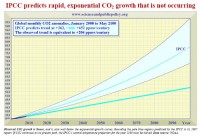
See larger image here.
Since 1980 temperature has risen at only 2.5F (1.5C)/century, not the 7 F (3.9 C) the IPCC imagines. Cooling for the past 8 1/2 years has been at a rate of 3.4F (1.9C) per century. Pages 14-15.
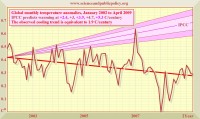
See larger image here.
Sea level rose just 8 inches in the 20th century and has been rising at just 1 ft/century since 1993. Though James Hansen of NASA says sea level will rise 246 feet, sea level has scarcely risen since the beginning of 2006. Page 16.
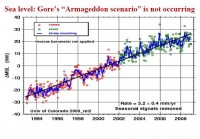
See larger image here.
Arctic sea-ice extent is about the same as it has been at this time of year in the past decade. In the Antarctic, sea ice extent - on a 30-year rising trend - reached a record high in 2007. Global sea ice extent shows little trend for 30 years. Pages 17-19.
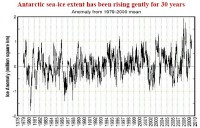
See larger image here.
The Accumulated Cyclone Energy Index is a 2-year running monthly sum of activity in all hurricanes, typhoons and tropical cyclones. It shows that there is now less severe tropical-storm activity than for 30 years. Page 20.
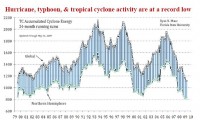
See larger image here.
Arctic sea-ice extent is about the same as it has been at this time of year in the past decade. In the Antarctic, sea ice extent - on a 30-year rising trend - reached a record high in 2007. Global sea ice extent shows little trend for 30 years. Pages 17-19.

See larger image here.
Solar activity at last shows signs of recovery. Will global cooling be replaced by global warming? Page 22.
The (very few) benefits and the (very large) costs of the Waxman/Markey Bill are illustrated at Pages 23-24.
Science Focus this month studies painting the world white to Save The Planet - another dumb idea. Page 25.
Finally, there’s our “global warming” ready reckoner, and our monthly selection of scientific papers. Pages 26-29. See full report here.
By Rachel Morris, Mother Jones News
You’ve heard of credit default swaps and subprime mortgages. Are carbon default swaps and subprime offsets next? If the Waxman-Markey climate bill is signed into law, it will generate, almost as an afterthought, a new market for carbon derivatives. That market will be vast, complicated, and dauntingly difficult to monitor. And if Washington doesn’t get the rules right, it will be vulnerable to speculation and manipulation by the very same players who brought us the financial meltdown.
Cap and trade would create what Commodity Futures Trading commissioner Bart Chilton anticipates as a $2 trillion market, “the biggest of any [commodities] derivatives product in the next five years.” That derivatives market will be based on two main instruments. First, there are the carbon allowance permits that form the nuts and bolts of any cap-and-trade scheme. Under cap and trade, the government would issue permits that allow companies to emit a certain amount of greenhouse gases. Companies that emit too much can buy allowances from companies that produce less than their limit. Then there are carbon offsets, which allow companies to emit greenhouse gases in excess of a federally mandated cap if they invest in a project that cuts emissions somewhere else - usually in developing countries. Polluters can pay Brazilian villagers to not cut down trees, for instance, or Filipino farmers to trap methane in pig manure.
In addition to trading the allowances and offsets themselves, participants in carbon markets can also deal in their derivatives - such as futures contracts to deliver a certain number of allowances at an agreed price and time. These instruments will be traded not only by polluters that need to buy credits to comply with environmental regulations, but also by financial services firms. In fact, a study (PDF) by Duke University’s Nicholas Institute for Environmental Policy Solutions anticipates that if the United States passes a cap-and-trade law, the derivatives trade will probably exceed the market for the allowances themselves. “We are on the verge of creating a new trillion-dollar market in financial assets that will be securitized, derivatized, and speculated by Wall Street like the mortgage-backed securities market,” says Robert Shapiro, a former undersecretary of commerce in the Clinton administration and a cofounder of the US Climate Task Force.
Banks like JPMorgan Chase, Morgan Stanley, and Goldman Sachs already have active carbon trading desks that deal in instruments connected to Europe’s cap-and-trade system and voluntary markets here. But business will explode if a cap-and-trade system becomes law. So it’s no surprise that the financial industry has taken an intense interest20in the fine print of the Waxman-Markey bill. According to data compiled by the Center for Public Integrity, the financial services industry has 130 lobbyists working on climate issues, compared to almost none in 2003. They represent companies like Goldman Sachs, JPMorgan Chase, and AIG (before it was shamed into temporarily halting its lobbying activities last fall). The industry “wants lawmakers to create a brand-new revenue stream for its bottom line, and cap and trade would do it,” says Tyson Slocum of Public Citizen, who is a member of a Commodity Futures Trading Commission (CFTC) advisory committee considering how carbon trading should be regulated. Read more here.
By Rick Rinehart, Boulder Page One Examiner
Scott Starin contributed what I thought was a valuable op-ed to the Boulder Daily Camera the other week, especially in view of Congress’s current wrangling over the Waxman-Market climate and energy bill. Starin, engineer, inventor, and failed Republican candidate for Colorado’s 2nd Congressional District in 2008, began his piece by stating that “Scientific method is a process of proposing and vetting theories through experimentation, analysis, observation, and test. This method is not conservative or liberal, populist or libertarian. True science is impartial, unemotional, and unbiased.”
And thus did Starin set the table for expressing his dismay over the current state of climate science, which he (along with millions of other people, I might add) believes has become wholly politicized. A so-called “skeptic” of anthropogenic global warming theoiry, Starin could not in the space provided tick off the many papers and books that support his view, so naturally in the comments section of the online edition of the Camera he was hammered by a few readers for not referring to any “peer-reviewed, scientific papers.”
I find it curious that, unless one is a climate scientist humbled by his discipline and is willing to admit it, the scientific community itself is seldom heard from when these dust-ups occur. Perhaps that is because, as climatologist Roy Spencer has written, “not one peer-reviewed scientific paper has ever discounted natural variation as a cause for climate change. Not one.” Indeed, the scientific literature on climate is leavened with words like “uncertainty;” certain forcings “could” or “might” do this or that to a climate system, tentative language reflecting the humility of trying to understand a highly complex system. As a University of Colorado scientist lamented during a “tense” meeting of the American Geophysical Union recently, “we have created a monster.”
The conceit that we know what caused the approximately 1 degree centigrade warming from the end of the Little Ice Age until the late 20th century, and that it is human enhancement of a life-giving trace gas, has been transformed (thanks to the popular press) into an assumption that we know more than we do about climate change. Here’s a short roster of other things we assume we understand, but don’t, really:
We don’t know the nature of gravity. We don’t know what causes ice ages. We don’t know how planets are formed. We don’t know what forces childhood to end at puberty. We don’t know how migrating animals find their way. We don’t know what the world’s supply of oil and natural gas is, but we do know that it has been consistently underestimated. We don’t know if there really is a link between consumption of fats and heart disease. We don’t know why we sleep or dream. We’ve failed to discover a biological basis for addiction or sexual orientation. We don’t know the human carrying capacity of the Earth (though many have made fools of themselves making dire prognostications.) We don’t know that organic foods are any better for us than non-organic foods.
And that’s just a start. On the occasion of its 125th anniversary in 2005 the magazine Science published a list of 125 significant questions that centuries of investigation have been unable to answer. The number was obviously arbitrary; it could have been a thousand. And to paraphrase essayist Joseph Epstein, the older we get, the more uncertain of things we become.
So I think Scott Starin got a bum rap when commenters jumped all over him for, of all things, being “unscientific.” Like a lot of scientists, Starin is merely asking that other factors, like solar variability, be considered before we embrace schemes from “cap and trade” to Boulder’s so-called “green building” initiatives. In fact, words spoken in 1999 by a prominent solar physicist, Eugene Parker, best capture the great uncertainty that continues to dominate climate science today:
“The inescapable conclusion is that we will have to know a lot more about the sun and the terrestrial atmosphere before we can understand the nature of contemporary changes in climate...In our present state of ignorance it is not possible to assess the importance of individual factors. The biggest mistake we could make would be to think that we know the answers when we do not.” See more here.
By Harold Ambler
What follows is an open letter to the Salon writer Peter Dizikes, who recently published an article about a new book by NASA scientist Gavin Schmidt on climate change.
Dear Mr. Dizikes:
I recently saw your overview of Gavin Schmidt’s new book as well as your interview with him on Salon.
I was surprised to see that you consider the effects of manmade global warming to be “oddly invisible.” Having studied the subject for a couple of years now, while performing my own research, it has been my observation that newspapers, magazines, and television news sources show images of supposed manmade climate change on a daily basis. Such images include: floods, polar bears, glacial calving, etc. If anything, images of global warming might be said to saturate western media.
As with so many other products generated by the AGW industry, Schmidt’s book Climate Change: Picturing the Science is part of an ongoing effort to frighten the credulous. Its messages include: weather will kill you, our moment on Earth is unique, climate did not used to change.
Had you wanted to fulfill the responsibilities of an objective and hard-hitting journalist, you might have asked Schmidt about the image of Lake Powell on his book’s cover. Now, of course, we are all told never to judge a book by its cover - but this is a visual book that demands to be judged on visual terms. There are a lot of people, unfortunately, who don’t know enough about the facts to perform this kind of analysis themselves. Failing to do so for them is a pity.
Were you aware, may I ask, of the controversial nature of the damming of the Colorado River that led to Lake Powell? Environmentalists were and are appalled by this particular dam. It has changed an important piece of the American natural landscape. But, like all manmade dams on Earth, it has changing water levels. Dammed lakes in the American west are particularly prone to fluctuating water levels, within single years, year to year, and on the decadal level. Water use varies as well, although it can be counted on to slowly increase. Using an image of lowered water level on Lake Powell, which is a reservoir, sitting in a desert, to indicate anything about climate change is perverse. I would even go to far as to call it anti-science.
The assumption that industrial production of CO2 has altered precipitation patterns is exactly that, an assumption. Further, what you are going to find, in the next decade, is that global temperatures are going to remain flat (as they have since 1998) and/or start to decline. What you are also going to find is that science writers in the American media establishment are going to peel off, one by one, from the AGW heterodoxy.
Group-think has affected many societies negatively, and it has not disappeared during our own time. The fact that neither Mr. Schmidt’s editor, nor his publisher, nor you, nor the photographer, nor Mr. Schmidt himself would stop to reflect on the oddity of this cover is enough to give one pause.
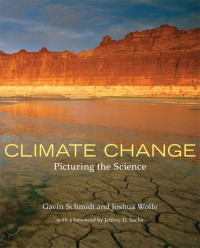
Sincerely yours,
Harold Ambler
By Martin Feldstein, Opinion in the Washington Post
The Obama administration and congressional Democrats have proposed a major cap-and-trade system aimed at reducing carbon dioxide emissions. Scientists agree that CO2 emissions around the world could lead to rising temperatures with serious long-term environmental consequences. But that is not a reason to enact a U.S. cap-and-trade system until there is a global agreement on CO2 reduction. The proposed legislation would have a trivially small effect on global warming while imposing substantial costs on all American households. And to get political support in key states, the legislation would abandon the auctioning of permits in favor of giving permits to selected corporations.
The leading legislative proposal, the Waxman-Markey bill that was recently passed out of the House Energy and Commerce Committee, would reduce allowable CO2 emissions to 83 percent of the 2005 level by 2020, then gradually decrease the amount further. Under the cap-and-trade system, the federal government would limit the total volume of CO2 that U.S. companies can emit each year and would issue permits that companies would be required to have for each ton of CO2 emitted. Once issued, these permits would be tradable and could be bought and sold, establishing a market price reflecting the targeted CO2 reduction, with a tougher CO2 standard and fewer available permits leading to higher prices.
Companies would buy permits from each other as long as it is cheaper to do that than to make the technological changes needed to eliminate an equivalent amount of CO2 emissions. Companies would also pass along the cost of the permits in their prices, pushing up the relative price of CO2-intensive goods and services such as gasoline, electricity and a range of industrial products. Consumers would respond by cutting back on consumption of CO2-intensive products in favor of other goods and services. This pass-through of the permit cost in higher consumer prices is the primary way the cap-and-trade system would reduce the production of CO2 in the United States.
The Congressional Budget Office recently estimated that the resulting increases in consumer prices needed to achieve a 15 percent CO2 reduction—slightly less than the Waxman-Markey target—would raise the cost of living of a typical household by $1,600 a year. Some expert studies estimate that the cost to households could be substantially higher. The future cost to the typical household would rise significantly as the government reduces the total allowable amount of CO2.
Americans should ask themselves whether this annual tax of $1,600-plus per family is justified by the very small resulting decline in global CO2. Since the U.S. share of global CO2 production is now less than 25 percent (and is projected to decline as China and other developing nations grow), a 15 percent fall in U.S. CO2 output would lower global CO2 output by less than 4 percent. Its impact on global warming would be virtually unnoticeable. The U.S. should wait until there is a global agreement on CO2 that includes China and India before committing to costly reductions in the United States.
The CBO estimates that the sale of the permits for a 15 percent CO2 reduction would raise revenue of about $80 billion a year over the next decade. It is remarkable, then, that the Waxman-Markey bill would give away some 85 percent of the permits over the next 20 years to various businesses instead of selling them at auction. The price of the permits and the burden to households would be the same whether the permits are sold or given away. But by giving them away the government would not collect the revenue that could, at least in principle, be used to offset some of the higher cost to households.
The Waxman-Markey bill would give away 30 percent of the permits to local electricity distribution companies with the expectation that their regulators would require those firms to pass the benefit on to their customers. If they do this by not raising prices, there would be less CO2 reduction through lower electricity consumption. The permit price would then have to be higher to achieve more CO2 reduction on all other products. Some electricity consumers would benefit, but the cost to all other American families would be higher.
In my judgment, the proposed cap-and-trade system would be a costly policy that would penalize Americans with little effect on global warming. The proposal to give away most of the permits only makes a bad idea worse. Taxpayers and legislators should keep these things in mind before enacting any cap-and-trade system. Read story here.
The Australian
THE Australian is to be congratulated for continuing to give space to diverse material and opinions relating to the complex science and economics surrounding climate change. As Ian Plimer writes ("Vitriolic climate in academic hothouse”, Opinion, 29/5), there has never been a climate change debate in Australia, only dogma. This needs to change. The UN’s Intergovernmental Panel on Climate Change has given apparent credibility to the dangerous climate change propaganda, which has been accepted uncritically by governments for nearly two decades. Scientific dissent has been actively opposed as government agencies, university cliques and some media channels resist open discussion.
The reality, as Plimer has elegantly demonstrated in his book, is that there is much uncertainty about climate science. In the past the Earth has warmed and cooled over a range of magnitudes and timescales for reasons that are not well understood. Indeed, anybody who claims to be able to predict what global temperature will be at the end of the century is either a charlatan or a fool. The truth is the IPCC got it about right in its first report in 1990, when it highlighted the many uncertainties of the science and concluded: there is a greenhouse effect; increasing carbon dioxide in the atmosphere will enhance the greenhouse effect; but we do not know the timing, the magnitude, or the regional implications.
Notwithstanding the more recent IPCC dogma, subsequent learning only further supports the view that the enhancement will be indistinguishable from natural climate variability.
John Nicol
Mon 01 Jun 09 (12:28pm) Thank you “sillyfilly” for your endorsement of our Climate Science Coalition and for publicising the fact that our scientific panel, with the exception of the chairman, myself, is composed of some of the brightest brains and most experienced persons in Australia, to deal with the problem of rationally examining climate change from many perspectivs, physics, chemistry, computer science, geology and meteorology with climate science. You will recognise, I am sure that the Green House Effect per se, lies in the realm of physics and/or chemistry NOT climatology. The experimental data on climate is provided by long histories of climate change given in gelogical records. Problems of the models is well documented by computer science as well as the apologetic information provided in Chapter 8 of the IPCC reports. John McLean has also pulled aprt the authoring of the many chapters and working group reports provided in AR4 IPCC 2007 and shown that the claimed 2,500 scientists in consensus, boils down to about fifty of whom many work together and are thus not independant.
Alan Siddons
Mon 01 Jun 09 (07:09am) From professor Whitehead’s comments, I can understand Ian Plimer’s frustration. Since CO2 increases are always seen to FOLLOW temperature increases in the geological record, how can one view Whitehead’s implicit reversal of this fact except as disingenuous? Open discussion is supposed to mean honest discussion. Carbon dioxide is an atmospheric trace gas, currently consisting of just one molecule among 2600. Every atmospheric molecule radiates heat in response to the thermal energy it absorbs from the earth’s surface. Yet no one talks about the heating effect of, say, nitrogen and oxygen. Because it doesn’t exist. These molecules merely react to surface heat; they don’t create it. Same for CO2.
Read more here.
By Lorrie Goldstein, Edmonton Sun
As long as politicians keep misleading us about what a cap-and-trade carbon market is—yesterday it was Ontario Premier Dalton McGuinty and Environment Minister John Gerretsen—I’m going to keep calling them on it. And this isn’ just about Ontario. Canada is going to implement cap-and-trade. So is the U.S. It’ coming no matter where you live.
Yesterday, Gerretsen claimed cap-and-trade is an environmental program to reduce greenhouse gas (GHG) emissions by industrial polluters. Bull. Cap-and-trade is an economic program run by governments to charge Canadians—not “polluters” who in fact get to pass along their costs, and more, to us—for something we’e never been charged for before. That is, the cost of emitting carbon dioxide into the atmosphere when energy is produced by burning fossil fuels.
Cap-and-trade shouldn’t even be announced by the environment minister. It should be announced by the finance minister. It means charging us more for almost everything, not just electricity, as politicians pretend. Yes, your electricity bill is going to skyrocket because of cap-and-trade and other reasons.
That’s already happened in Europe, which has had cap-and-trade since 2005 and where the only reason GHG emissions finally went down after rising in 2006 and 2007, is that the global economy crashed in 2008. That’s what lowers emissions. In a recession, we buy less stuff because we have less money, which means it takes less energy to make it.
Using less
Because we have no practical way at present to stop carbon dioxide from going into the atmosphere when fossil fuels are burned, the only way to do it is to increase the cost of fossil fuels, so we’ll use less. That’s all cap-and-trade does. It’s government trying to reduce GHG emissions by, in effect, deliberately creating a recession in which all of us use less energy because we have to pay more for it and, further, have less money to buy anything else. Introducing cap-and-trade in good economic times would be suspect. Introducing it during the worst global recession since the Great Depression is stark, raving, mad.
And it’s not just electricity that’s going to go up. So is the cost of food and virtually everything we buy, because it takes energy to grow it, manufacture it and transport it to market. So is the cost of heating and cooling our homes, for the vast majority. So is our water bill, because it takes electricity to pump it to our homes.
The cost of government is going to go up because governments are increasingly subsidizing—with our money—hopelessly inefficient “renewable energy” projects such as wind and solar power, where the technology is years away from reliable, affordable, on-demand use, compared to traditional energy sources. Cap-and-trade is government and industry sitting down behind closed doors to cut up a big fat wad of even more of our money than they take now, in a negotiation where we don’t get a seat at the table.
We don’t yet know how much it will cost, other than mega-billions, because no government has provided what we need to make even a guesstimate—what the “cap” on total annual carbon dioxide emissions will be, how fast it will be lowered, how big the cap-and-trade market will be, all of which will affect the market price of a “carbon credit,” which is just a pollution permit allowing the bearer (industry) to emit a tonne of carbon dioxide.
Finally, the legacy of cap-and-trade is not going to be a greener world. It’s going to be the world’s largest new stock market, trading exclusively in a stock called carbon credits, where the mega-profits will be made by speculators, hedge funds, and the same financial and investment houses that just finished crashing the global economy. See the story here. H/T Dr. Benny Peiser, CCNet.
By Kay Zeiger-Buccola, Woodinville Letter to the editor Woodinville Weekly
Representative Jay Inslee pulled a very smooth “Bait & Switch” when confronted about his refusal to listen to opposing views on Global Warming hysteria and its impending restrictions on life-giving CO2. (Woodinville Town Hall meeting May 9).

He favors the largest back-door tax in world history - and that is “Cap & Trade.” CO2 is not a pollutant. It is essential to life. And CO2 has never been scientifically proven to cause global warming, global cooling or any other climate change. CO2 elevation follows warming. CO2 is not the cause of any climate changes and therefore should not be “capped.”
Almost 32,000 scientists, 9,000 of whom are PhDs, have signed and published a petition stating there is no scientific basis for CO2 restrictions. The debate is not over. Mr. Inslee sits on the Environment Committee and was rude to Dr. Patrick Michaels of the UNIPCC when he tried to present another side. And his Democrat-controlled committee sent Lord Christopher Monckton back home to England, refusing to allow his testimony, on the day Al Gore was the featured guest. Republicans, who had invited Monckton, had to take their third choice. Disallowing the opposition to speak is not democracy!
When confronted with these facts, Mr. Inslee proceeded to drone on about ocean acidification as if saying, “Well, if you’re not afraid of Global Warming, try on this new fear...”. Any fear will do as long as it seems to justify drastic restrictions on our access to energy, our prosperity, and, ultimately, our liberty.
See Dr. Hoffman’s response to question about coral’s ability to withstand changes in temperatures and acidification in this story

Also see Craig’s book CO2, GlobalWarming and Coral Reefs here and his paper on CO2 Science here. In that paper he begins with this introduction: In a paper recently published in Geophysical Research Letters, Silverman et al. (2009) created a model of coral calcification based on field observations of gross community calcification as a function of aragonite saturation state (Ωarag), sea surface temperature (SST) and live coral cover, after which they calculated calcification rates for more than 9,000 reef locations using model values of Ωarag and SST at different atmospheric CO2 concentrations, which exercise led them to conclude that “by the time atmospheric partial pressure of CO2 will reach 560 ppm, all coral reefs will cease to grow and start to dissolve.”
What’s wrong with this picture?
For starters—and as actually acknowledged by the researchers themselves—“coral reefs were exposed throughout their geological history to higher temperatures and CO2 levels than at present and yet have persisted,” which is a pretty amazing admission for them to make, in light of the fact that they have boldly declared that when the atmosphere’s CO2 concentration reaches 560 ppm in the not too distant future, “all coral reefs will cease to grow and start to dissolve.” he then goes on to list peer review after peer review observation based papers that refute that model based projection.


